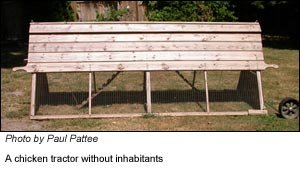Editor’s note: This is part of our occasional series featuring inexpensive ways to live sustainably.
Sustainable living doesn’t have to be limited to the home — the garden is another place for opportunities. Local sustainability experts Ed and Dana Bressette say their method keeps down weeds, pests and fertilizer use all at the same time by just putting chickens in the garden.
 How do you put chickens in the garden and not let them eat everything, or worse, get eaten? Simple: Build a chicken tractor, the Bressettes suggest.
How do you put chickens in the garden and not let them eat everything, or worse, get eaten? Simple: Build a chicken tractor, the Bressettes suggest.
Chicken tractors come in any shape or size desired by the creator. You can build one that looks like a coop house or one that isn’t heavy enough to require a trailer or tractor to move it. Some have wheels with handles to allow rolling; some have only handles for lifting.
The number of tractor types is mindboggling. One popular design is in a triangular style that allows for easy moving, and easily accessible nest boxes on the ends. Just a little door on the outside will do. They also enjoy ramps to go up and down for nesting as well as a cover to keep out weather. Some covers are attached permanently, some with removable sections to allow the sun on a nice day.
If you live in an area with a frequency of predators, you need to use a heavier gauge wire in your construction, make sure your construction is durable materials and well crafted. Most importantly, be sure to put wire completely across the bottom of the tractor so weasels, raccoons, foxes, coyotes and other predators can’t get under. That would be the one and only shortcoming of a chicken tractor without a bottom. A bottom is not needed in every location.
Costs of building or purchasing a chicken tractor vary widely, due to size, materials, and addition of other amenities such as running water or a heater for the feathered “weeders.”
You will need to move your chickens approximately every two weeks, as that is about how long it takes for them to eat their area to dirt. If your design incorporates wheels, try to use a wheel assembly that moves as you need. Some wheel assemblies have been imported from overseas because of their special design. One type from England (pictured) folds up and down as you lift the tractor on that end to allow rolling while moving and then replacing the tractor to the ground when done.
There are many published books on the subject, and one particularly informative one, “Chicken Tractor: The Permaculture Guide to Happy Hens and Healthy Soil” published by Good Earth Publications, can be found at Amazon.com. ($13.97 or less for used).
Using chickens as a sustainable way of gardening is environmentally friendly. It prevents usage of pesticides and nonorganic fertilizers. The by-products of this gardening solution are farm-fresh eggs, natural fertilizer, extra meat for the table (if they don’t become pets first) and hours of time saved from pulling weeds in the garden that most people would rather use for anything else.
Information and designs: www.winecountrycoops.com www.easy~garden.com/chicken.htm www.sru.edu/pages1290.asp www.goodearthpublications.com www.kountrylife.com/content/gal231.htm www.dragonflyfarm.net/chickentractor.shtml
UNDERWRITTEN BY THE FUND FOR NONPROFIT NEWS (NEWSMATCH) AT THE MIAMI FOUNDATION, THE ANGEL GUILD, ADVERTISERS, DONORS AND PEOPLE WHO SUPPORT INDEPENDENT, NONPROFIT LOCAL NEWS